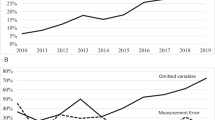Abstract
This paper proposes a detailed decomposition for nonlinear econometric models, covering well-known limited dependent variable models such as the logit, probit and Tobit models. The purpose of the proposed method is to relate between-group differences in an outcome variable to differences in observable characteristics. The method overcomes disadvantages of existing decompositions for nonlinear models discussed in the literature. In particular, it leads to a unique decomposition and absorbs the present nonlinearities in a natural way. In this paper, the proposed decomposition is theoretically identified and it is shown how it can be estimated and how inference can be conducted. It is then compared to existing decomposition methods. An empirical application is presented where the results from the proposed decomposition method are compared with results from existing methods. It is demonstrated that linear methods such as the Oaxaca-Blinder decomposition may not be appropriate in the presence of substantial nonlinearities, and that the decomposition approach proposed in this paper leads to a theoretically sensible decomposition of the outcome differential.
Similar content being viewed by others
References
Amemiya, T.: Advanced econometrics. Basil Blackwell, Oxford (1986)
Bartle, R.G., Second edition: The elements of real analysis. Wiley, Chichester (1976)
Bauer, T., Sinning, M.: An extension of the Blinder-Oaxaca decomposition to nonlinear models. AStA. Adv. Stat. Anal. 92(2), 197–206 (2008)
Becker, S.O., Ichino, A.: Estimation of average treatment effects based on propensity scores. Stata J. 2(4), 358–377 (2002)
Blinder, A.S.: Wage discrimination: Reduced form and structural estimates. J. Hum. Resour. 8(4), 436–455 (1973)
Dehejia, R.H., Wahba, S.: Causal effects in nonexperimental studies: reevaluating the evaluation of training programs. J. Am. Stat. Assoc. 94(448), 1053–1062 (1999)
Even, W.E., Macpherson, D.A.: Plant size and the decline of unionism. Econ. Lett. 32(4), 393–398 (1990)
Even, W.E., Macpherson, D.A.: The decline of private-sector unionism and the gender wage gap. J. Hum. Resour. 28(2), 279–296 (1993)
Fairlie, R.W.: The absence of the African-American owned business: An analysis of the dynamics of self-employment. J. Labor. Econ. 17(1), 80–108 (1999)
Fairlie, R.W.: An extension of the Blinder-Oaxaca decomposition technique to logit and probit models. J. Econ. Soc. Meas. 30(4), 305–316 (2005)
Fitzenberger, B., Kohn, K., Wang, Q.: The erosion of union membership in Germany: determinants, densities, decompositions. J. Popul. Econ. 24(1), 141–165 (2011)
Fortin, N., Lemieux, T., Firpo, S.: Decomposition methods in Economics. In: Ashenfelter, O., Card, D. (eds.) Volume 4A of Handbook of Labor Economics, chapter 1, pp. 1–102. Elsevier, Amsterdam (2011)
Greene, W.H., 7th edition: Econometric Analysis. Pearson, Boston, Mass (2012)
Horowitz, J.: The bootstrap. In: Heckman, J.J., Leamer, E. (eds.) Volume 5 of Handbook of Econometrics chapter 52, pp 3159–3228. Elsevier, Amsterdam (2001)
Jann, B.: fairlie: Stata module to generate nonlinear decomposition of binary outcome differentials Available fromhttp://ideas.repec.org/c/boc/bocode/s456727.html (2006)
LaLonde, R.J.: Evaluating econometric evaluations of training programs with experimental data . Am. Econ. Rev. 76(4), 604–620 (1986)
Nopo, H.: Matching as a tool to decompose wage gaps. Rev. Econ. Stat. 90(2), 290–299 (2008)
Oaxaca, R.L.: Male-female wage differentials in urban labor markets. Int. Econ. Rev. 14(3), 693–709 (1973)
Oaxaca, R.L., Ransom, M.R.: On discrimination and the decomposition of wage differentials. J. Econom. 61(1), 5–21 (1994)
Shorrocks, A.F.: Decomposition procedures for distributional analysis: a unified framework based on the Shapley value. J. Econ. Inequal. 11, 99–126 (2013)
Yun, M.-S.: Decomposing differences in the first moment. Econ. Lett. 82(2), 275–280 (2004)
Author information
Authors and Affiliations
Corresponding author
Electronic supplementary material
Below is the link to the electronic supplementary material.
Rights and permissions
About this article
Cite this article
Schwiebert, J. A detailed decomposition for nonlinear econometric models. J Econ Inequal 13, 53–67 (2015). https://doi.org/10.1007/s10888-014-9291-x
Received:
Accepted:
Published:
Issue Date:
DOI: https://doi.org/10.1007/s10888-014-9291-x




